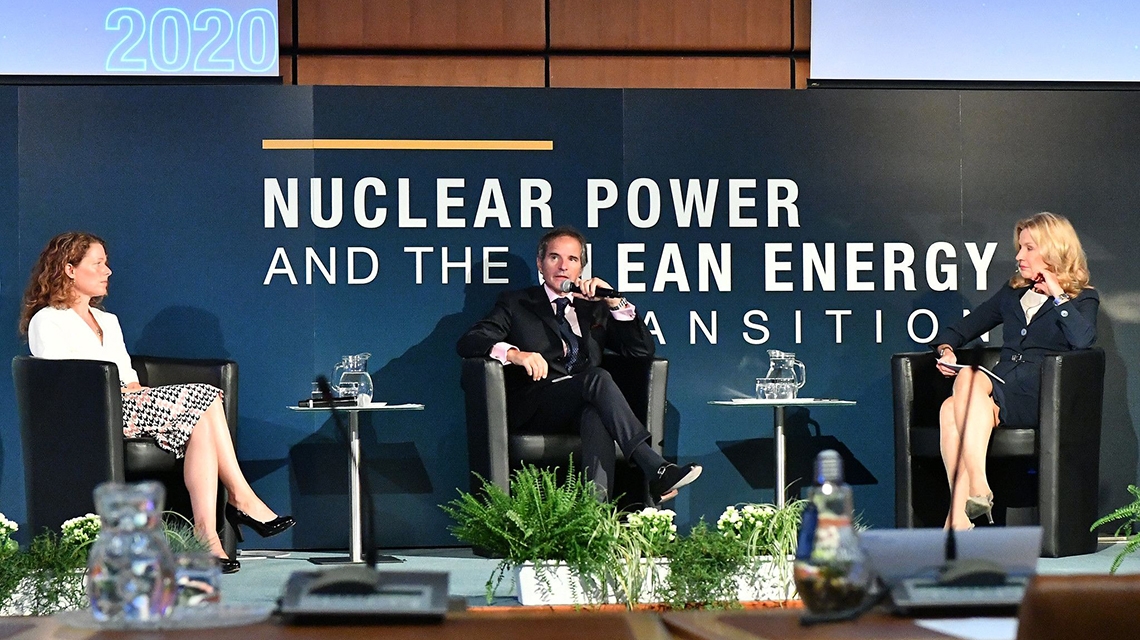Nuclear Key to the Clean Energy Transition – Conclusions of the 2020 IAEA Scientific Forum
The closing Session of the 2020 IAEA Scientific Forum: Nuclear Power and the Clean Energy Transition. (Photo: D. Calma/IAEA)
Nuclear power must have a seat at the table in global discussions over energy policies to curb emissions and meet climate goals, as technical and scientific advances open the door to better economics and greater public acceptance of this low carbon source of energy.
These are some of the conclusions of this year’s IAEA Scientific Forum, where ministers, scientists and other experts from industry and civil society came together for two days of talks on scientific and technological advances in nuclear power that could help drive the global transition to clean and sustainable energy. The event, which included both in-person and virtual presentations, featured lively discussions from participants both in the room and online.
Participants discussed innovations that are making nuclear power a more affordable and attractive energy option. These include advances in large reactors, emerging technologies such as advanced fuel and small modular reactors (SMRs), engineering breakthroughs extending the operational lifetime of existing reactors, and new developments in waste management such as the construction of the world’s first deep geological repository for spent nuclear fuel.
This article sums up the discussions of the four sessions. Highlights of the opening session can be found here, and detailed programme and presentations here.
The first session opened with a look at the data underpinning the need for nuclear power in the clean energy transition. It then discussed how new construction methods and innovative reactor designs can support the deployment of advanced nuclear power to achieve climate goals. It also examined engineering breakthroughs for the long-term operation of existing reactors as well as the role of artificial intelligence and digital technology in future systems combining nuclear with renewables.
The Director General of the World Nuclear Association, Agneta Rising, set the scene by recapping the scenario by the Intergovernmental Panel on Climate Change (IPCC), according to which nuclear energy has to expand six-fold by 2050 and make up 25% of the world’s electricity generation to keep the global temperature rise “bearable”. While recent projections by the IAEA show that future growth in nuclear power is unlikely to match that scenario, Rising said, “innovation can help nuclear energy meet many of the challenges which are holding back its growth.”
The need to accelerate innovation, such as through new partnerships and R&D funding, will be key for this growth, panellists said, as advances in the large-scale deployment of both small and large reactors can help drive down costs. Small modular reactors, for example, hold the promise of being a more viable and affordable option for many countries, including developing nations, due to lower up-front costs. Rita Baranwal, Assistant Secretary for the Office of Nuclear Energy in the United States Department of Energy, said innovation in this area in the United States is being driven by the private sector, showing a paradigm shift and providing an opportunity. “We do see a lot of interest from venture capitalists, philanthropists, investing in the nuclear energy sector and we certainly need to continue to leverage and take advantage of it.”

Rafael Mariano Grossi, IAEA Director General, delivers his remarks at the closing session of the 2020 IAEA Scientific Forum: Nuclear Power and the Clean Energy Transition. (Photo: D. Calma/IAEA)
Expanding the lifespan of the current reactor fleet will also be crucial: long term operation is the cheapest, most effective investment for low carbon capacity with immediate impact, experts agreed. Innovations in the manufacturing of replacement components, for example, could help extend the lifetime of many of the world’s existing 442 nuclear power reactors in operation, two thirds of which are over 40 years old.
Nuclear is a powerful driver of innovation and boosts R&D from fundamental physics to the development and manufacturing of new material, instrumentation, robotics and digital technology, said Cedric Lewandowski, Vice President of France’s EDF.
In addition, SMRs combined with artificial intelligence and digital technology have the potential to strengthen the flexibility and scalability of nuclear power, particularly in electricity markets in which renewables play a large role, said Chae Young Lim, Senior Vice President of the Korea Atomic Energy Research Institute.
The panel also reviewed advances in innovative or so-called Generation IV reactor designs, such as Molten Salt Reactors or Lead Cooled Fast Reactors, which are under development and could be deployed after 2030. Such reactors can offer significant advantages in terms of inherent safety, optimal use of natural resources and waste reduction.
The second session looked at using nuclear energy to slash emissions in hard-to-abate sectors, such as industry and transport. Non-electric nuclear applications, including desalination, process heat and hydrogen production could be key to help unlock nuclear energy’s potential, but industrial operation of demonstration plants needs to be urgently scaled up, panellists said.
Kazuhiko Kunitomi, Deputy Director General at Japan’s Atomic Energy Agency, for example, said steel making industries need a large amount of hydrogen, and future High Temperature Gas Reactors (HTGR), for example, could supply this. Shannon Bragg-Sitton from the United States’ Idaho National Laboratory echoed the potential of high temperature reactors, as these could help drive down the cost of hydrogen production. For now, she said the US was focused on using existing water-cooled reactors to demonstrate hydrogen production through electrolysis.
Session 3 looked at innovations that can help manage the energy life cycle, including the use of fast reactors. These reactors use neutrons that are not slowed down by a moderator, such as water, to sustain fission, and can extract up to 70 times more energy than current light water reactors, thereby reducing the need for fresh uranium fuel. This leads to a conservation of natural resources, emphasized Anzhelika Khaperskaya, Senior Project Manager at Russia’s State Atomic Energy Corporation Rosatom. “Recycling and reprocessing can greatly enhance the sustainability of nuclear power plants, and when used in closed fuel cycle with fast reactors, the waste footprint can be significantly reduced,” she added.
Liisa Heikinheimo, Deputy Director General at Finland’s Ministry of Economic Affairs and Employment, shared her country’s experience in the development of a deep geological disposal facility for spent fuel, which is planned to be operational in 2024, a global first. She spoke of the importance of public acceptance for such a project. “In general in Finland we have positive public attitudes [towards nuclear], and the reason for this is taking care of nuclear waste,” she said.
The last session looked at some of the barriers hindering greater deployment of nuclear power in the transition to clean energy, such as concerns over costs and financing. The IAEA’s role in fostering technological innovation and facilitating technology transfer to its Member States was also highlighted.
Gloria Kwong, Acting Head at the Division of Nuclear Technology Development and Economics at the Nuclear Energy Agency of the Organisation for Economic Co-operation and Development (OECD), said that innovations in the nuclear sector that increase cost competitiveness need government support, with concrete policies when necessary. “Nuclear power has high capital costs and requires investments,” she said, making the case for the need to ensure competition on a level playing field for policies that value clean energy and energy security.

Kirsty Gogan, CoFounder Energy for Humanity delivers her remarks at the closing session of the 2020 IAEA Scientific Forum: Nuclear Power and the Clean Energy Transition. (Photo: D. Calma/IAEA)
During the closing session, Director General Rafael Mariano Grossi joined a panel with Bernard Bigot, Director-General of the ITER Organization and representatives from civil society, namely Kirsty Gogan, CoFounder of the non-governmental organization Energy for Humanity, and Fabricia Pineiro, Member of the Board of Directors of the International Youth Nuclear Congress.
“Fission and fusion are very different but could be very complementary,” said Bigot. “There is a lot to learn from each other,” he said, including in areas related to materials, qualification of systems (an equipment quality control mechanism) and components and robotics. He said the two organizations must work together, “in a joint partnership that could advance both forms of energy.”
Gogan reiterated that to advance discussions on the role of nuclear power and improve public perceptions, we need to step up communication efforts, among others. “Ultimately, the scale and urgency demand that we are evidence-based and rigorous in our solution, but we must also be rigorous in our communications and public engagement.” She talked about the importance of building a wider coalition around nuclear power and emphasized the importance of communicating about shared values.
As a representative from the young generation of nuclear scientists and engineers, Pineiro said that the nuclear sector is innovating in many areas, including in key industrial processes related to automation and remote operations. This attracts young people to the industry, as “our work has a direct positive impact and gives us a sense of pride and purpose”.
Director General Grossi said discussions at the Scientific Forum had focused on timely and pertinent questions, the answers to which clearly demonstrated that the nuclear industry is not stagnant. Advanced reactors, including SMRs “are a reality and there is a lot of interest,” including form countries looking to introduce nuclear power for the first time, he said. Challenges remained, such as the financing of nuclear power plants and public communication, but innovations in this regard “are being pursued in different parts of the world.”
“From an IAEA perspective, we have an important role to play in ensuring that the discussion has a firmer support basis,” he said, adding that the Agency can take this debate forward on the road to COP26 in Glasgow next year. “I see a recognition of the contribution of nuclear. Simply because it is a good solution, a solution that brings low carbon energy, that helps development,” he concluded. With concerted efforts from all sectors – government, industry and civil society – the expansion of nuclear power could have a meaningful impact on the clean energy transition. “But we need to face the debate and challenges and respond with determination,” he added. “This is indispensable.”






No comments:
Post a Comment